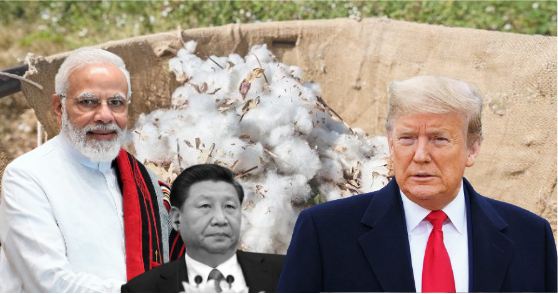India’s cotton exports is set to touch new heights as former President Donald Trump’s blanket ban on cotton and its related products from China’s Xinjiang Uyghur Autonomous Region (XUAR) has started to show its effect.
Reported by TFI, an online witch-hunt has begun in China against western clothing companies like H&M, Nike, Adidas and others after they refused to use cotton as raw material from the Xinjiang province, plucked out of the fields using forced Uighur labours.
The “I support Xinjiang cotton” online campaign has garnered thousands of eyeballs on the Chinese social media platforms. However, the real reason behind the sudden campaign, when the statements were released late last year is Donald Trump’s administrative decision to disrupt the supply chain market of Xinjiang.
Reported by TFI in December last year, the Trump administration had intensified the US-China trade war with the ban on imported cotton from the Chinese, Xinjiang Development and Building Corps (XPCC). Trump’s blanket ban on the import of cotton and its products from China had sent irreversible jitters down the spine of the CCP, as China produces more than 20 per cent of the world’s cotton with most of it coming from Xinjiang.
Read more: China exploits Xinjiang for massive cotton and tomato exports. Now Trump is all set to ban them
It took time for the effects of Trump’s ban to kick in but once it did, an agitated CCP started looking for ways to put pressure on America and the western world to reverse the order. And this exactly is the opening for the cotton market in India to expand its reach and become the world leaders.
The ban is likely to see an increase in cotton imports from countries such as India, Vietnam, Pakistan and Bangladesh. India is the largest producer of cotton in the world, although it contains the highest wastage in the world, it is also the cheapest in comparison with the US, Brazil, and Australia and therefore there is a large potential to export.
China’s cotton exports in 2019 were $14.1 bn, equalling 26.6 per cent of total global exports, while India contributed 11.8 per cent, worth $6.3 billion and less than half of China’s worldwide export. This is the opportune moment for India to fill the gap and become world leaders in the sector.
While the extensive domestic demand has stopped India from becoming the export kings, the bumper produce in the previous and current calendar year can be used to prop up numbers under the export column. So far, the numbers have been encouraging.
India’s cotton exports increased by 27.5 per cent year-on-year during December 2020 and by 96 per cent for the October-December quarter, compared with the same period a year earlier.
Currently, both Vietnam and Bangladesh are buying a good amount of cotton from India, which is expected to produce at least 49.5 million bales (one bale is around 170 kgs) this season till September 2021, according to the Cotton Association of India. According to Reuters news agency, India’s cotton exports are expected to jump 40 per cent in 2020/21 from a year ago to 7 million bales, the highest in seven years.
The central government needs to be alert in not letting this opportunity slide by idly. India can single-handedly reduce the American dependency on cotton from Bangladesh, Indonesia, Vietnam and The Philippines. And that again has been made possible due to Trump’s brilliant policies.
































Good ita beneficial to Indian cotton exports as well as Indian farmers